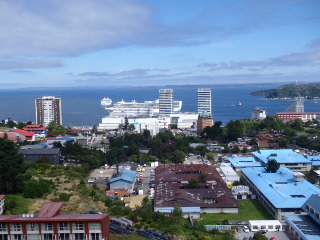“A bay bordered by steep hills, stately old
Victorian homes, cable cars - no, it's not San Francisco, California. Welcome to
Valparaiso.” Founded in 1536, and named after the birthplace of conquistador
Diego de Almagro, Valparaiso is Chile's oldest city. It is also the gateway to
Chile's central valley and the capital of Santiago, which is about a 1.5 hour
drive inland.
Our day included a city tour of Vina del Mar, the
playground city for vacationers, and Valpariso, where the ship docked, and
which is a relatively poor working man’s city and then a trip to the Casablanca
Valley, which is the heart of Chile’s renowned fine wine district.
Our tour started at 8:00 am when we met up with our
guide for the day, Christian “The Van Man”.
The weather forecast was 78 degrees and sunny. It was not…yet. We had typical Valparaiso weather which meant
fog in the morning and then sunny skies for the afternoon. Our tour headed toward Vina del Mar, the
beach and resort town next to Valparaiso. The water is really too cold here for
swimming as the current comes from Antarctica.
First stop was at the Floral Clock. Christian said there are only 5 of these
clocks in the world. Didn’t know
that! I think this was the 3rd
floral clock we have seen on vacations.
Two to go to see them all! The
city is full of parks along the waterfront and is very clean. When we stopped to take a photo of the
castle, Cerro Castillo, the site of the summer residence of Chile’s President,
we found these horses having breakfast before they started pulling their
carriages.
We stopped by the outside of the town’s museum for
a look at the Easter Island statue of a moai.
It was brought over here in 1951.
Next we traveled to the Casablanca Valley to visit
a couple wineries and do a little wine tasting. It was only about 10 am but we’re
sure it was 5 o’clock somewhere! The
wines were excellent!
With the skies clear and sunny now, we headed back
to Valparaiso for a look at that city before getting back on the ship. We stopped at an overlook to the city. It would have been fun to take the funicular
(a car on rails to access the city at the top of the hills) but it was too
crowded and we didn’t have time. So our
van drove us up for a view. As with the
other cities we have visited, there is a lot of graffiti on the buildings. But here many of them have murals and are
considered graffiti “art”.
It was a very good day; we enjoyed this port. Next port is
Coquimbo, Chile.



















































